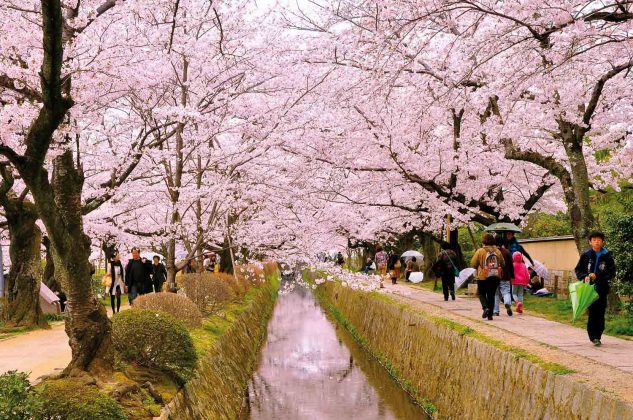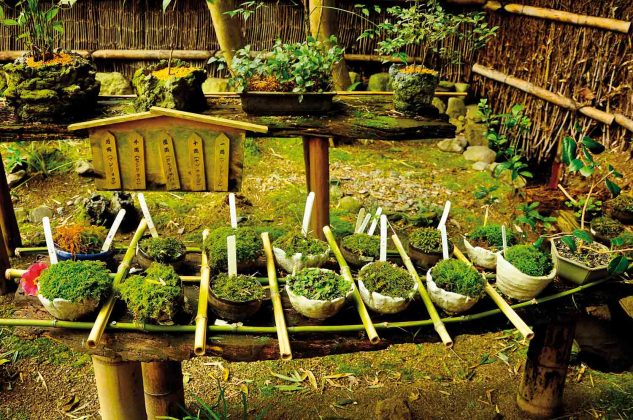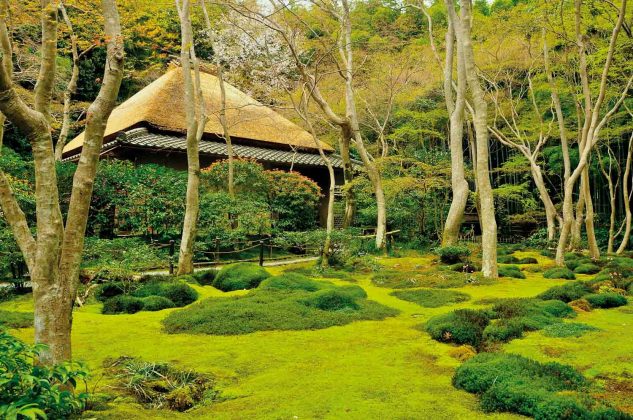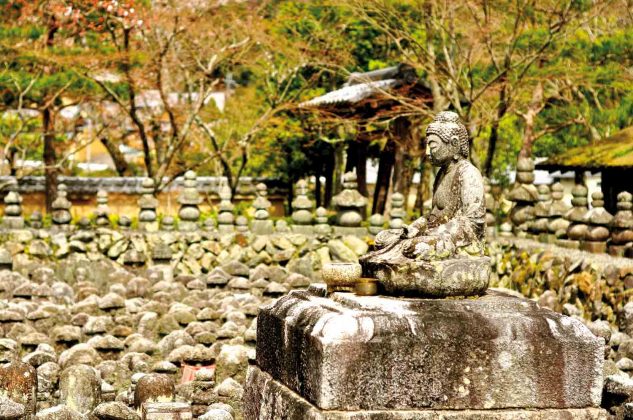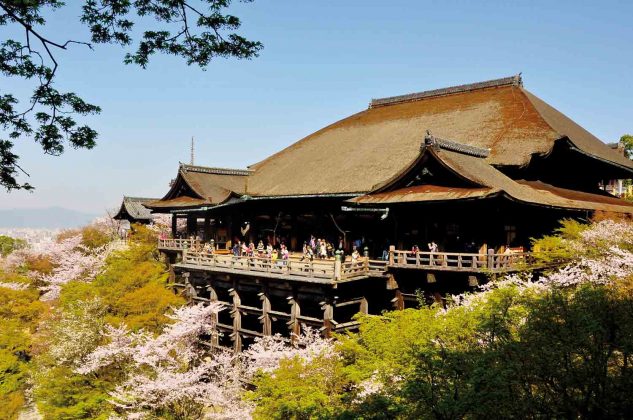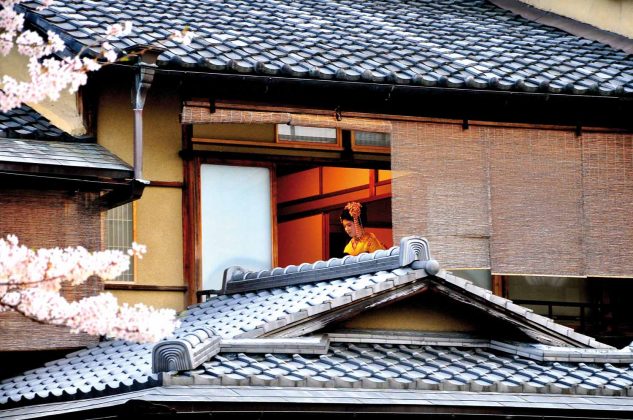Tranquil Zen temples… artistic rock gardens… and old neighbourhoods with wooden houses along narrow alleys. Kyoto lives up to the image we have of an ancient, mystical Japan and spring renders this scenery irresistible because that’s when Japan is swathed in the salmon pink sakura [cherry blossoms].
Northern Higashiyama
If you are in Kyoto during this a magical time, head directly to the ‘Path of Philosophy’ in Higashiyama [the eastern hills]. This pedestrian street along a canal lined with blooming cherry trees on either side is where adjectives fail and clichés ring true… Abandon any effort to describe this pink-hued scenery on a postcard, and instead meander in the footsteps of one of its famous patrons—the 20th century philosopher Nishida Kitaro.
Once you manage to free yourself from this trance, there are plenty of Buddhist temples and Shinto shrines in Kyoto to keep you busy. The Eikan-do temple, built in 855 by the priest Shinsho, has its massive complex interspersed with pagodas, rock gardens, ponds and waterfalls. If the size doesn’t impress you; the precise designs of the immaculately raked sand, stylised rock arrangements, rectangular hedges and convex shrubs in the gardens definitely will.
While we were there, a calming hush presided that caused us to talk in whispers and against which we could hear the water gurgle and rain drops fall. Along Garyu-ro, a long wooden corridor leading to Taho-to pagoda, was a Sui-kin-kutsu. ‘Koto of water drops: a sound ornament of the Japanese Garden’, the sign read. When we gently poured water using a wooden ladle into the bamboo contraption and pressed our ears closely, we could catch the sound of the drips.
‘Concentrate on the sound the water drops make’ was the instruction. The soft melody of Koto, a traditional Japanese harp reached our ears.
Ahead of us, a cluster of monks clad in a grey shade that matched the dull sky, were chanting sutras and marching out of Amida-do hall. This is the hall that enshrines the unique statue of Buddha glancing over his shoulders.
A mere 10-minute walk away is Nanzen-ji. Its 16th century dark wooden Sanmon [main gate], fringed by the soft-coloured cherry blossoms makes it a favourite of photographers. Even more so, when Japanese women dressed in spring inspired kimonos, complete with geta [wooden flip-flops] and tabi [white socks] are seen posing on the steps.
Right outside Hojo—Nanzen-ji’s main hall—a giant brick aqueduct passes through the temple compound. This structure raises a few eyebrows, especially in a space where not a pebble seems out of place. As it turns out, during the Meiji period, this aqueduct was used to carry water and goods between Kyoto and its neighbouring prefecture.
While Nanzen-ji is at the southern end of the Path of Philosophy, Ginkaku-ji or the Silver Pavilion is at the northern end. This Zen temple initially was a villa built in 1482. It takes the name from the fact that its resident, Shogun Ashikaga Yoshimasa, desired to plate it in silver. However his plans were not realised. Even without the embellishment, it’s worth a visit only to view stretches of meticulously raked white sand in the shape of a cone and ripples, representing Mount Fuji and the lake.
It’s interesting to observe how gardens in the east imitate or reflect nature as opposed to those in the western world like Versailles or Boboli gardens that impose order over nature with their geometrical shapes and symmetry.
Arashiyama
Start your Arashiyama [the western hills] walk from Tenryu-ji, a Zen temple from 1339. The wind whistles through the trees and the tinted sunlight trickles in from gaps to make a pattern of light and shade along the path. It is an ethereal stroll
through this 200-metre stretch cocooned by soaring bamboo trees.
If you thought nature relegated moss to gutters and drainpipes, witness their cultural upliftment at the hands of Zen masters at Gio-ji’s luxurious moss garden. On display are more than a dozen different kinds of mosses cultivated here. Once again, the impeccable order of the place mystifies. There’s no lawn mowing or leaf-blowing… it’s as if the garden is the work of invisible hands.
Before descending, take a peek at what seems like an outlandish prehistoric scene at Adashino Nenbutsu-ji temple. 8000 stone Buddhist images and pagodas are arranged in straight lines, with a stupa and a statue of Buddha at the centre. These crude weathered stones were originally grave-markers for the dead, buried in the Adashino region in ancient times. They remained undiscovered until about a 100 years ago, when they were brought inside the temple, to repose the souls of the dead.
Despite being a revered spiritual home, the tinge of melancholy is undeniable. The sight of toys and flowers left by bereaved parents at the Jizo shrine—a Bodhisattva guarding the souls of unborn children—is heart wrenching.
If this was heavy, a 25-minute ride on the Sagano Romantic Train will lift your spirits. Boarding at Torokko Arashiyama station, we chugged along the breath-taking terrains by the Hozu River, through valleys and in-between mountains. Disembark at Torokko Kameoka and walk to Umahori Station to catch a train back to Kyoto.
Southern Higashiyama
You can enter the ancient temple of Kiyomizu-dera, through a giant red Sanmon above a flight of stairs. While another flight of stairs leads to the main hall that enshrines a statue of Kannon Bodhisattva or goddess of mercy. After all the climbing, reward yourself with the panoramic view from the hall’s massive veranda jutting out over the mountainside.
If you haven’t had the chance to observe hanami or blossom viewing up close, a Japanese custom since the Heian period, Maruyama Park should be your next stop. Goza mats are laid, colourful nibbles in hanami bento boxes are out, so are the wines and sake. The quiet of the park is replaced by the party revellers’ uninhibited banter.
Straddling the eastern bank of Kamogawa River, the picturesque hanamachi or geisha district of Gion is crammed with shops, restaurants and the most expensive and exclusive [unless you have connections and deep pockets, entry is improbable] 17th century teahouses, where the geisha and maiko [apprentice geisha] entertain guests in an intimate environment of traditional music, dance, drinking and flirting.
Visit hanamikoji-dori [Flower Viewing Street] during evenings or walk along the scenic Shirakawa canal lined with blooming cherry trees. If you’re lucky, a window of an ochaya overlooking the canal will open, offering you the elusive vision of a geisha entertaining.
Good to know:
Accommodation:
To enjoy Japanese hospitality stay at a Ryokan —traditional Japanese inn with tatami matted floors, futon beds, communal baths and local cuisine on offer. However, a cheaper alternative would be the western style business hotels.
Dining:
The cobbled alley of Ponto-cho on the west bank of the Kamogawa river is lined with traditional wooden machiya, housing restaurants, bars and teahouses. Around dusk, there’s a good chance of spotting a geisha or a maiko, scurrying to or from an appointment.
Try downtown Kyoto for inexpensive dining options.
Day trips:
Reach the ancient capital of Nara in just 45 minutes for 690 yen [one way] on JR rapid train Miyakoji from Kyoto station. Download ‘Nara Walks’, from http://www.jnto.go.jp/eng/location/regional/nara/
Transportation:
To explore the city via buses and subways, buy Kyoto Sightseeing one day [1200 yen] or two day [2000 yen] cards.
Travel advice:
Complaints about tourists acting like paparazzi when they spot a geisha are on the rise. The popularity of the book and movie Memoirs of a Geisha, propelled by the exclusivity of teahouses, has created a celebrity-like status for geishas. If you too are aiming for that fleeting geisha shot, act respectfully.
This was first published in the May 2014 issue of Complete Wellbeing.


